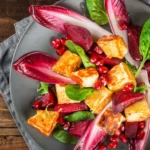West African Fufu is a versatile and beloved staple in African cuisine, particularly in countries such as Ghana, Nigeria, and Cote d’Ivoire. It is a dough-like food made from starchy ingredients like cassava, plantains, yams, or a combination of these. Fufu is typically served as an accompaniment to various soups, stews, and sauces, and is enjoyed for its smooth texture and ability to absorb flavors. Let’s explore the process of making fufu and its cultural significance.
Ingredients:
- Cassava, plantains, yams, or a combination of these (depending on preference)
- Water
Instructions:
- Select the starchy ingredient(s) for making fufu. Cassava is the most commonly used, but you can also use plantains, yams, or a combination to create different variations of fufu.
- Peel and cut the chosen starchy ingredient(s) into chunks. If using cassava, remove the tough outer skin and fibrous core.
- Place the chunks in a large pot and add enough water to cover them. Bring the water to a boil and cook the starchy ingredients until they are soft and easily pierced with a fork. The cooking time will vary depending on the ingredient(s) used.
- Once cooked, remove the pot from heat and drain the water, reserving a small amount for later use.
- Mash the cooked starchy ingredients using a wooden spoon or a traditional fufu pounding stick called a “pestle” and mortar. Alternatively, you can use a blender or food processor to achieve a smooth consistency.
- As you mash, gradually add small amounts of the reserved cooking water to soften the mixture and facilitate the blending process. The goal is to obtain a smooth, elastic, and pliable dough-like consistency.
- Once the fufu has reached the desired texture, transfer it to a serving dish.
- Fufu is traditionally served as small rounded portions alongside soups, stews, or sauces. To eat fufu, tear off a small portion, roll it into a ball using your hands, and use it to scoop up the soup or sauce.
Fufu holds great cultural significance in West African cuisine, often being associated with communal meals and special occasions. It is considered a comfort food and is enjoyed by people of all ages. The process of making fufu, particularly the traditional method of pounding it in a mortar, is often a communal activity where family members or friends take turns pounding and preparing the fufu together.
It’s worth noting that fufu can be made from scratch using raw ingredients, which requires additional steps like peeling, grating, and fermenting the cassava or other starchy components. This process can be time-consuming and labor-intensive. As an alternative, instant fufu powders are available in some markets, which require mixing with water and heating to achieve a similar consistency.
Whether prepared traditionally or using instant powders, fufu remains a versatile and cherished staple in West African cuisine. Its neutral flavor allows it to complement a wide range of soups, stews, and sauces, making it a beloved and essential part of African culinary traditions.








